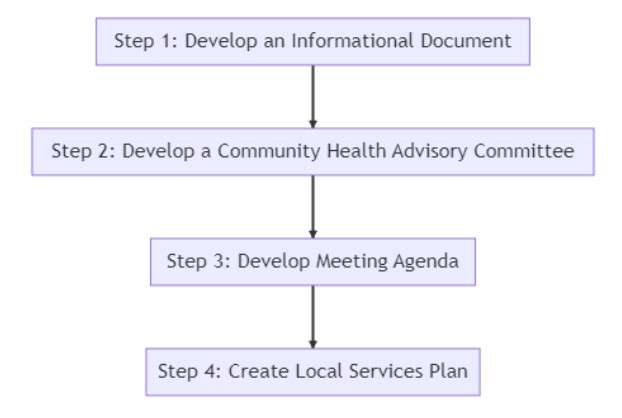Use the "Next" and "Previous" buttons below to move to the next or previous chapter in this module OR
Use the table of contents on the right to navigate to a chapter in this module.
Creating the Local Services Plan
The process of crafting a Local Services Plan (LSP) is a meticulous journey that requires foresight, collaboration, and strategic planning. Recognizing the significance of this endeavor, the Colorado Department of Education (CDE) recommends that Local Education Agencies (LEAs) initiate this process at least 10 months prior to the LSP due date. This proactive approach ensures ample time for a thorough community health needs assessment, community engagement, and iterative refinement. Remember that the CDE School Health Services Consultant is also a resource available to LEAs during this process.
The image below outlines the main steps in creating the Local Services Plan. Each step is further detailed below the image. For more information, click here to access the Local Services Plan Development Strategies (PDF)

Step 1: Develop an informational document
Building on the foundational understanding of the need for a Local Services Plan, this initial step focuses on creating a comprehensive informational document. This document will detail the district's School Health Services Program and set clear expectations for the subsequent stages of the LSP development process.
- Begin by detailing the state of the district's School Health Services Program.
- Outline the 5-year Local Services Plan development process, ensuring clarity and comprehensiveness. Processes assessing health needs, prioritizing those needs, and determining how funds will be assigned should be clearly detailed.
- Set clear expectations for participation on the Community Health Advisory Committee, detailing roles and responsibilities.
- Schedule dates for upcoming meetings, ensuring ample prior notification for all participants. Make sure to reserve meeting rooms ahead of time.
For assistance in thinking through what questions to ask, consider reviewing the CDE LSP Health Needs Assessment Support document. This document does not need to be turned in with the LSP. Click here to access this support document.
Step 2: Develop a Community Health Advisory Committee
With the informational document in place, the next crucial step is to foster community collaboration. This involves forming a Community Health Advisory Committee, with a diverse membership from the local community. The committee should not be exclusively composed of LEA staff. A diverse community can provide collective insights and expertise, which will be invaluable in ensuring the LSP is both comprehensive and relevant to the community's needs.
- Using the informational document developed in Step 1, identify potential local service providers and stakeholders to be part of the committee. This can include county agencies, Community Based Organizations, School Based Health Centers, parents, students, and many others.
- Create an email list of these community members, ensuring diverse representation.
- Inquire about any existing community health assessments from the county Department of Health and Environment to inform the LSP development process.
- Send out meeting invitations with dates, locations, and the informational document to prospective members, ensuring they are well-informed ahead of the meetings.
Step 3: Develop meeting agenda
Having established the Community Health Advisory Committee, it's time to facilitate productive discussions. This step involves crafting a structured meeting agenda that will guide the committee through the process. The agenda ensures that all pertinent topics are covered, building on the foundation set by the informational document and the diverse perspectives of the committee members.
- Building on the foundation set by the informational document and the formation of the Community Health Advisory Committee, draft a structured meeting agenda.
- Start the agenda with a welcome and introduction segment to foster a collaborative environment.
- Establish ground rules for the meeting to ensure productive discussions.
- Review the informational document together, clarifying goals, responsibilities, and addressing any queries.
- Identify and prioritize student health needs, including the needs of the uninsured/underinsured population. (Remember: Up to 30% of total funds can be allocated to the uninsured.)
- Review the proposed budget for the five-year LSP and discuss the allocation of funds to each identified health need. (Remember: Reimbursement allocation percentages for health services do not need to be identified in the LSP.)
Step 4: Create Local Services Plan
After thorough discussions and collaborative efforts in the previous steps, the final stage is to consolidate all the insights and decisions into the Local Services Plan. This plan will detail the strategies, priorities, and actions that the district will undertake over the next five years, ensuring the health and well-being of its students.
- Using insights from the previous steps, especially the discussions from the Community Health Advisory Committee meetings, begin drafting the Local Services Plan. (Click here for the latest template of the Local Services Plan)
- Develop procedures for monitoring and reporting the delivery of LSP health services, ensuring transparency and accountability.
- Ensure that the LSP aligns with the guidelines provided by the Colorado Department of Education (CDE) and reflects the collective decisions made throughout the process.
 | Remember that crafting the LSP is a collaborative community effort. In drafting the LSP, ensure clarity and comprehensiveness so that any member of the public can easily grasp how the plan to spend reimbursement dollars will satisfy the identified health needs. |
|---|